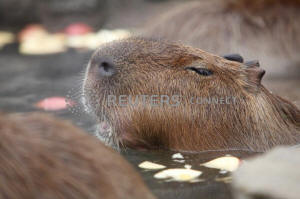|
They might not know it, but the five capybaras are the star
attraction at the zoo some two hours by train south of Tokyo,
the host of this year's summer Olympic Games.
Zookeepers are banking on the tourism appeal of the world's
largest rodents to cash in on the fortuitous coincidence of
Japan hosting the Olympics in the Chinese Zodiac's Year of the
Rat.
"The capybaras are the highlight of our zoo, so we're taking the
Year of the Rat as an opportunity to push their popularity up
even more," said Masahiro Takeda, the deputy zookeeper of Izu
Shaboten Koen.
"We're really hoping that this will catch on with people from
all over the world visiting Japan too."
Ironically, the capybaras, which are native to the tropical
jungles of South America, have been credited with improving the
zoo's popularity in the quieter winter months.
The winter tradition of giving the capybaras daily baths started
almost 40 years ago, when a zoo attendant cleaning their pen
with hot water turned around to find that they were huddled
together trying to sit in one of the warm puddles.
In a country with nearly 3,000 hot spring resorts, the baths
quickly became a fixture at Izu Shaboten Koen and other zoos
across Japan, where the number of capybaras jumped from 126 in
2006 to 422 in 2016.
The rodents have inspired a popular plush toy and associated
merchandise called 'Kapibarasan,' and online video clips of
bathing capybaras have been viewed hundreds of thousands of
times.
At Izu Shaboten Koen, the capybaras, which weigh in at anywhere
between 35 to 65 kilograms (77 to 143 pounds), eat apples and
leaves dumped by their keeper into their hot bath before
drifting off to sleep. When awake, visitors can don special
mittens to pet and hand-feed the giant hamster-like animals.
Daytrippers who stop for a bite to eat at the zoo's restaurant
can indulge in a capybara-themed beef burger, which features a
bun in the shape of the animal, with chocolate eyes and mouth
drawn on.
Takeda said he did not have exact data, but estimated the zoo
received 20-30% more visitors during the winter since the it
started showcasing the bathing capybaras.
"I'd only ever seen the capybaras sit in hot springs on TV, so I
really wanted to see it in person,” said Kayo Kogai, 23, who was
visiting Izu Shaboten Koen on Saturday.
“They look so relaxed … I would really like to join them in
their bath,” Kogai’s friend Mizuki Aoki, 23, added with a laugh.
(This story corrects to show that capybaras take daily, not
twice-daily, baths in paragraph 7 and removes extraneous word in
paragraph 12)
(Reporting by Sakura Murakami; editing by Jane Wardell)
[© 2020 Thomson Reuters. All rights
reserved.] Copyright 2020 Reuters. All rights reserved. This material may not be published,
broadcast, rewritten or redistributed.
Thompson Reuters is solely responsible for this content.

|
|






